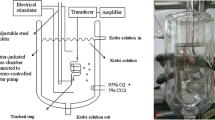Abstract
The present study was devised to determine the effects of amphetamine on the sympathetic function of human nasal mucosa. A tissue bath method was employed on the vitro preparations of nasal turbinate mucosa from adult patients with nasal allergies or hypertrophic rhinitis. The effects of amphetamine on the contractile response of isolated human nasal mucosal blood vessels were investigated following electrical field stimulation and methoxamine. The results showed that amphetamine inhibited field stimulation and antagonized the effects on mucosal contraction induced by methoxamine. Likewise, the drug increased mucosal basal tension but had local drug toxicity when a 10−4 M solution was used. Amphetamine could potentiate mucosal contraction induced by norepinephrine or epinephrine. The study indicated that amphetamine may increase sympathetic function by potentiating the effect of norepinephrine and that high concentrations of amphetamine may actually antagonize a-adrenoceptors.
Similar content being viewed by others
References
1. Gray NE, Saidi P (1978) Methamphetamine intoxication. Am J Med 64:537–539
2. Holderfer RN, Jensen RA (1987) The effects of peripheral damphetamine, 4-OH amphetamine and epinephrine on maintained discharge in the locus coeruleus with reference to the modulation of learning and memory by these substances. Brain Res 417:108–117
3. Jackson RT (1980) An in vitro technique for testing nasal vasodilating agents. Otolaryngol Head Neck Surg 88:434–438
4. Naumann HH (1980) Surgery of the paranasal sinuses. In: Naumann HH (ed) Head and neck surgery (English edn). Saunders, Philadelphia, pp 390–391
5. Piazza PV, Deminiere JM, Le Moal M, Simon H (1989) Factors that predict individual vulnerability to amphetamine self-administration. Science 245:1511–1513
6. Taylor WE (1989) An alternative to the transpalatal maxillary nerve block. Laryngoscope 99: 109–110
7. Tripathi KD (1988) Adrenergic system and drugs. In: Tripathi KD (ed) Essential of medical pharmacology, 2nd edn. Jaypee, New Delhi, pp 93–108
8. Ubatuba FB (1973) The use of hamster stomach in vitro as an assay preparation for prostaglandins. Br J Pharmacol 49:662–666
9. Wang H-W, Jackson RT (1989) Do cholinergic neurons directly innervate nasal blood vessels? Rhinology 26: 139–146
10. Wang S-W, Wang H-W, Wang J-Y (1993) Effects of cocaine on human nasal mucosa. Eur Arch Otorhinolaryngol 250: 245–248
Author information
Authors and Affiliations
Rights and permissions
About this article
Cite this article
Wang, H.W., Wang, S.W., Su, W.Y. et al. Effects of amphetamine on human nasal mucosa. Eur Arch Otorhinolaryngol 253, 498–500 (1996). https://doi.org/10.1007/BF00179957
Received:
Accepted:
Issue Date:
DOI: https://doi.org/10.1007/BF00179957




